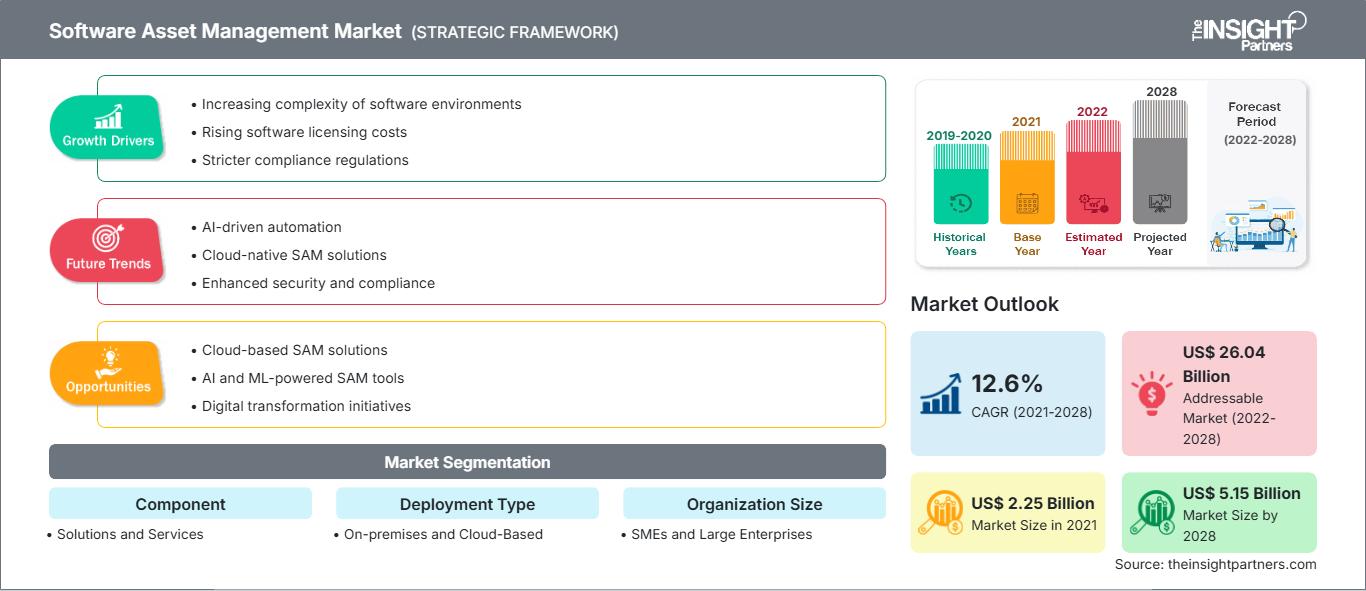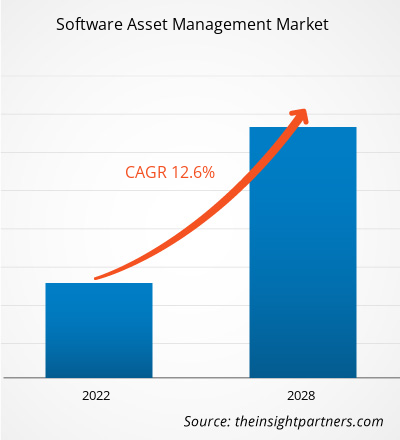[연구 보고서] 소프트웨어 자산 관리 시장은 2021년 22억 5,037만 달러에서 2028년 51억 5,051만 달러로 성장할 것으로 예상되며, 2021년부터 2028년까지 연평균 성장률 12.6%로 성장할 것으로 예상됩니다.
조직 내 소프트웨어 애플리케이션의 취득, 구현, 사용, 유지 관리 및 폐기를 가능하게 하는 시스템, 규칙 및 절차의 관리를 소프트웨어 자산 관리(SAM)라고 합니다. 소프트웨어 자산 관리 시장은 기업이 라이선스 계약을 준수하고 소프트웨어에 과도한 지출을 하지 않도록 보장하는 IT 자산 관리의 한 구성 요소입니다. 소프트웨어 자산 식별, 최종 사용자 라이선스 계약(EULA)의 유효성, 그리고 무료 소프트웨어의 적절한 사용은 모든 SAM 활동의 핵심 목표입니다. SAM 문서는 불법 복제 방지 소송으로부터 회사를 보호하고, 의도치 않은 라이선스 오용을 최소화하며, 네트워크상의 섀도우 소프트웨어를 제어할 수 있도록 지원합니다.
대규모 조직의 소프트웨어 자산 관리는 소프트웨어 구매, 구독, 라이선스 및 패치 관련 정보를 관리하는 데이터베이스의 개발 및 유지 관리가 필요할 정도로 복잡할 수 있습니다. 이러한 팀은 소프트웨어 라이선스 갱신, 새로운 라이선스 계약 협상, 그리고 거의 또는 전혀 사용되지 않는 소프트웨어 탐지 및 제거를 담당하는 경우가 많습니다. 소프트웨어 자산 관리 시장은 구매한 소프트웨어 라이선스 수를 감사하고 이를 설치된 라이선스 수와 조정하여 다양한 모바일, 데스크톱, 데이터 센터 및 클라우드 인벤토리 소스에서 정보를 수집하는 방식을 자동화합니다. SAM 도구는 남은 라이선스 수를 추적할 수도 있습니다. 비용 절감을 위해 이러한 정보를 활용하여 사용되지 않는 소프트웨어를 삭제하거나 재할당할 수 있습니다.
요구 사항에 맞게 이 보고서를 사용자 정의하십시오.
이 보고서의 일부, 국가 수준 분석, Excel 데이터 팩을 포함하여 모든 보고서에 대한 사용자 정의를 무료로 받을 수 있을 뿐만 아니라 스타트업 및 대학을 위한 훌륭한 제안 및 할인을 이용할 수 있습니다
소프트웨어 자산 관리 시장: 전략적 통찰력

-
이 보고서의 주요 주요 시장 동향을 확인하세요.이 무료 샘플에는 시장 동향부터 추정 및 예측에 이르기까지 데이터 분석이 포함됩니다.
COVID-19 팬데믹이 소프트웨어 자산 관리 시장에 미치는 영향
COVID-19 팬데믹은 소프트웨어 자산 관리 시장에 긍정적인 영향을 미쳤습니다. 기업들은 COVID-19 팬데믹으로 인해 재택근무 환경의 확대와 같은 새로운 어려움에 직면하고 있습니다. COVID-19 발생은 라이선스 및 비용을 최적화하고 IT 자산에 대한 투자 수익률(ROI)을 높이기 위해 디지털 기술을 도입하고 소프트웨어 자산 관리 솔루션 및 서비스의 잠재력을 활용해야 할 필요성을 부각시켰습니다. 더욱이, 2020년 팬데믹의 도래는 글로벌 시장 운영에 많은 어려움을 야기했습니다. 선진국의 의료 인프라가 확진자 증가로 붕괴됨에 따라, 공공 의료 비상사태는 정부와 시장 참여자들이 개입하여 2028년에 종료되는 예측 기간 동안 손실을 회복하기 위해 수행된 연구 개발 계획의 공동 노력을 통해 시장 운영 및 수익 회복을 지원해야 할 것입니다. 또한, 투자 증가는 향후 몇 년간 업계에 긍정적인 영향을 미칠 것입니다.
시장 분석 - 소프트웨어 자산 관리 시장
자산 수명 주기 관리에 대한 수요 증가로 소프트웨어 자산 관리 시장 수요 증가
모든 절차와 IT 인프라 사용자는 회사의 소프트웨어 자산을 수명 주기 전반에 걸쳐 관리, 규제 및 보호해야 합니다. IT 자산 관리(ITAM), IT 서비스 관리(ITSM), 하드웨어 자산 관리(HAM)는 모두 소프트웨어 자산 관리(SAM)의 하위 집합입니다. ITAM은 소프트웨어 및 하드웨어 자산 관리를 개선하는 동시에 비용 절감을 최적화하고 감사 위험을 제한하는 것을 목표로 합니다. 현대 기업은 소프트웨어를 일상 운영의 필수적인 요소로 간주합니다. 평균적으로 한 조직은 직원의 다양한 업무를 지원하기 위해 288개의 애플리케이션을 사용합니다. 성공적인 자산 수명 주기 관리(LCAM) 또는 수명 주기 자산 관리(LCAM)를 구현하면 전략 기업은 자산이 최대 성능에 도달하는 시점과 비즈니스에 얼마나 오랫동안 서비스를 제공할 수 있는지 파악할 수 있습니다. 예를 들어, Blissfully는 소프트웨어 자산 관리 및 SaaS(Software as a Service) 관리 애플리케이션으로, 비용 절감, 모든 소프트웨어 공급업체 관리, 생산성 향상, 소프트웨어 시스템 보안 강화에 도움을 줍니다. 따라서 자산 수명 주기 관리에 대한 필요성이 증가함에 따라 소프트웨어 자산 관리 시장에 대한 수요도 증가하고 있습니다.
구성 요소 세그먼트 분석 - 소프트웨어 자산 관리 시장
소프트웨어 자산 관리 시장은 구성 요소를 기준으로 솔루션과 서비스로 세분화됩니다. 소프트웨어 자산 관리 솔루션은 데이터 센터 운영 관리자가 모든 자산을 식별, 위치 파악, 시각화 및 관리하고 향후 성장을 위한 용량을 계획할 수 있도록 지원합니다. 소프트웨어 자산 관리 프로그램을 구현하는 것은 전략적 목적, 즉 획득한 소프트웨어 라이선스 수와 실제로 사용되거나 소비된 라이선스 수를 일치시키는 것을 의미합니다. 성공적인 소프트웨어 자산 관리 프로그램은 설치된 모든 소프트웨어가 개별 공급업체 라이선스 계약의 약관을 준수하고, 구매한 라이선스 수와 사용량 간의 균형을 유지하도록 확인해야 합니다. 소프트웨어 공급업체 또는 Business Software Alliance(BSA)와 같은 제3자의 감사를 받는 경우, 기업은 소프트웨어 불법 복제와 관련된 책임을 줄일 수 있습니다.
배포 유형 세그먼트 분석 - 소프트웨어 자산 관리 시장
소프트웨어 자산 관리는 배포 유형에 따라 온프레미스 및 클라우드 기반으로 분류됩니다. 클라우드 기반 소프트웨어 자산 관리 솔루션은 다양한 화면 크기(데스크톱, 노트북, 태블릿, 핸드헬드 기기, 스마트폰)의 다양한 기기에서 사용하기가 더욱 편리합니다. RFID, 바코드, NFC 데이터를 클라우드에 저장하여 검색을 더욱 쉽게 할 수도 있습니다. 클라우드 기반 시스템은 접근성이 뛰어나 여러 위치에서 진행하는 감사 및 내부 및 외부 자산 감사를 병행하는 데 적합합니다. 일반적으로 여러 기기에서 자산 사진을 업로드하고 의견을 추가하는 것이 더 간단합니다. 클라우드 기반 소프트웨어 자산 관리 솔루션을 사용하면 버전 관리, 감사 및 다중 승인 체인을 쉽게 구현할 수 있습니다.
조직 유형별 세그먼트 분석
소프트웨어 자산 관리 시장은 조직 유형에 따라 중소기업과 대기업으로 구분할 수 있습니다. 대기업은 생산성 향상을 위해 고급 소프트웨어에 막대한 투자를 할 수 있습니다. 대기업에는 SAM(서비스 자산 관리) 도구가 필요합니다. 소프트웨어 자산 관리 도구를 사용하면 수동 프로세스를 자동화, 가속화 및 개선할 수 있습니다. 또한, 소프트웨어 자산 관리는 다양한 산업 분야의 조직이 IT 자산의 성능과 민첩성을 효과적으로 개선하는 데 도움을 줍니다.
산업별 세그먼트 분석 - 소프트웨어 자산 관리 시장
산업별 소프트웨어 자산 관리 시장은 정부, 소매 및 소비재, 의료 및 생명 과학, 금융 서비스 제공업체(BFSI), 미디어 및 엔터테인먼트, 제조, IT 및 통신 등으로 세분화됩니다. 디지털 기술은 제조업의 비즈니스 접근 방식을 변화시키고 있습니다. 기술은 산업 4.0에서 중요한 역할을 할 것으로 예상됩니다. 소프트웨어 자산 관리는 이 새로운 제조 시대의 핵심 요소가 될 것입니다. 시장 참여자들은 경쟁 우위를 확보하기 위해 첨단 기술과 기능을 통합하여 신제품 혁신과 개발에 집중합니다. 기술 인텔리전스 분야의 글로벌 선두 기업인 Snow Software에 따르면, Snow Atlas는 기업이 온프레미스 및 클라우드 환경 모두에서 기술 투자를 파악하고 모니터링하며 최적화할 수 있도록 처음부터 개발된 유일한 통합 플랫폼입니다. 소프트웨어 및 자산 관리(SAM), 서비스형 소프트웨어(SaaS) 관리, 그리고 서비스형 IT 서비스 관리(ITSM) 통합은 소프트웨어 액세스 관리 솔루션에 포함된 새로운 클라우드 네이티브 플랫폼에서 사용할 수 있는 최초의 솔루션입니다. 소프트웨어 자산 관리 시장은 구성 요소 기준으로 솔루션과 서비스로 구분됩니다. 배포 유형 측면에서 소프트웨어 자산 관리는 온프레미스 및 클라우드 기반으로 분류됩니다. 조직 유형에 따라 소프트웨어 자산 관리 시장은 중소기업과 대기업으로 구분할 수 있습니다. 소프트웨어 자산 관리 시장은 산업별로 정부, 소매 및 소비재, 의료 및 생명 과학, 금융 서비스(BFSI), 미디어 및 엔터테인먼트, 제조, IT 및 통신 등으로 세분화됩니다. 지역별로는 북미, 유럽, 아시아 태평양, 중동 및 아프리카, 남미로 세분화됩니다.
소프트웨어 자산 관리 시장
The Insight Partners의 분석가들은 예측 기간 동안 소프트웨어 자산 관리 시장에 영향을 미치는 지역별 동향과 요인을 면밀히 분석했습니다. 이 섹션에서는 북미, 유럽, 아시아 태평양, 중동 및 아프리카, 그리고 중남미 지역의 소프트웨어 자산 관리 시장 부문 및 지역별 현황도 살펴봅니다.
소프트웨어 자산 관리 시장 보고서 범위
| 보고서 속성 | 세부 |
|---|---|
| 시장 규모 2021 | US$ 2.25 Billion |
| 시장규모별 2028 | US$ 5.15 Billion |
| 글로벌 CAGR (2021 - 2028) | 12.6% |
| 이전 데이터 | 2019-2020 |
| 예측 기간 | 2022-2028 |
| 다루는 세그먼트 |
By 구성 요소
|
| 포함된 지역 및 국가 |
북미
|
| 시장 선도 기업 및 주요 회사 프로필 |
|
소프트웨어 자산 관리 시장 참여자 밀도: 비즈니스 역학에 미치는 영향 이해
소프트웨어 자산 관리 시장은 소비자 선호도 변화, 기술 발전, 그리고 제품의 이점에 대한 인식 제고 등의 요인으로 인한 최종 사용자 수요 증가에 힘입어 빠르게 성장하고 있습니다. 수요가 증가함에 따라 기업들은 제품 및 서비스를 확장하고, 소비자 니즈를 충족하기 위한 혁신을 추진하며, 새로운 트렌드를 적극 활용하고 있으며, 이는 시장 성장을 더욱 가속화하고 있습니다.

- 을 얻으세요 소프트웨어 자산 관리 시장 주요 주요 플레이어 개요
소프트웨어 자산 관리 시장 – 회사 프로필
- Microsoft Corporation
- IVANTI
- SNOW 소프트웨어
- BMC SOFTWARE, INC.
- CERTERO
- FLEXERA
- IBM Corporation
- MICRO FOCUS
- SERVICENOW
- BROADCOM, 주식회사
- 과거 분석(2년), 기준 연도, CAGR을 포함한 예측(7년)
- PEST 및 SWOT 분석
- 시장 규모 가치/거래량 - 글로벌, 지역, 국가
- 산업 및 경쟁 환경
- Excel 데이터세트
최근 보고서
관련 보고서
사용 후기
구매 이유
- 정보에 기반한 의사 결정
- 시장 역학 이해
- 경쟁 분석
- 고객 인사이트
- 시장 예측
- 위험 완화
- 전략 기획
- 투자 타당성 분석
- 신흥 시장 파악
- 마케팅 전략 강화
- 운영 효율성 향상
- 규제 동향에 발맞춰 대응






















 무료 샘플 받기 - 소프트웨어 자산 관리 시장
무료 샘플 받기 - 소프트웨어 자산 관리 시장